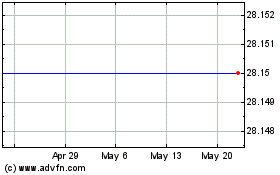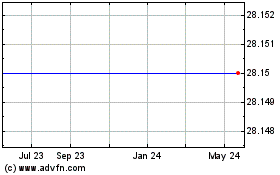Schering-Plough Expands Vicriviroc Phase II Study in Treatment-Naive Patients With HIV
July 15 2009 - 8:30AM
PR Newswire (US)
CCR5 Antagonist Evaluated in Novel Nucleoside-Sparing Regimen
Designed to Provide Additional Treatment Options, Preserve other
HIV Drugs for Subsequent Use KENILWORTH, N.J., July 15
/PRNewswire-FirstCall/ -- Schering-Plough Corporation (NYSE:SGP)
today announced that it has extended to stage two an ongoing Phase
II clinical study with vicriviroc, its investigational CCR5
antagonist, for use in first-line therapy of adult treatment-naive
HIV-infected patients with R5-type virus only. In this study,
vicriviroc is being evaluated in a novel nucleoside-sparing regimen
that is designed to provide additional options for treatment-naive
patients in a once daily regimen, while preserving other drug
classes for subsequent lines of treatment. The study is being
conducted in two stages, with the first stage initiated in January
2008 and having enrolled 95 patients (47-48 per treatment arm).
Following 24 weeks of treatment, a formal interim analysis was
conducted and the safety results were reviewed by an independent
Data Safety Monitoring Board. Based on these results, the study has
been extended to stage two, in which the enrollment target is an
additional 105 patients. Unlike other classes of HIV drugs that
work to inhibit viral replication within human CD4+ cells, most of
which are part of the immune system, vicriviroc is an HIV entry
inhibitor designed to prevent the virus from infecting healthy CD4
cells by blocking its predominant entry route, the CCR5
co-receptor. Approximately 80-90 percent of treatment-naive
patients have virus that uses the CCR5 co-receptor.(1) "CCR5
antagonists, such as vicriviroc, have a novel mechanism of action
and may play a unique role as physicians seek to construct new HIV
regimens to meet the specific needs of their patients," said Joseph
C. Gathe, Jr., M.D., F.A.C.P., clinical instructor, department of
internal medicine, Baylor College of Medicine, Houston, and lead
investigator for the study. "A class-sparing vicriviroc regimen for
initial treatment could potentially expand options for patients by
offering a new first-line therapy, while having the additional
benefit of preserving the current first-line therapy and subsequent
regimens for future use." In the study, the virologic benefit of
vicriviroc administered once-daily as a single 30 mg tablet in
combination with ritonavir-boosted atazanavir(2) is being compared
to a control group receiving Truvada (emtricitabine and tenofovir
disoproxil fumarate)(3) plus ritonavir-boosted atazanavir, which is
a currently recommended option for first-line therapy. Atazanavir
is a product in the protease inhibitor (PI) class of HIV
medications. Truvada is a combination product in the
nucleoside(tide) reverse transcriptase inhibitor (NRTI) class. The
standard of care for treatment-naive HIV-infected individuals is to
combine three drugs from two classes to initiate antiretroviral
therapy. The combinations characteristically use two NRTIs with
either a non-nucleoside reverse transcriptase inhibitor (NNRTI) or
a ritonavir-boosted PI.(4) While these combinations have been
demonstrated to be highly effective, long-term tolerance may be
limited by the toxicity specifically associated with nucleosides,
which can include neuropathy, myopathy, renal toxicity, hepatic
steatosis, lactic acidosis, bone marrow suppression, fat atrophy
and, with certain agents, increased risk of myocardial
infarction.(5-7) About the Phase II Naive Study This randomized,
controlled, open-label study is projected to enroll approximately
200 treatment-naive HIV-infected adult patients at more than 35
sites in North America, Central America, Europe and South Africa.
Patients coinfected with hepatitis B or C may be included in the
study. The primary efficacy endpoint of the study is the mean
change from baseline in viral load (log10 HIV RNA) at week 48 of
treatment. A key secondary efficacy endpoint is the proportion of
patients with plasma HIV RNA less than 50 copies/mL at week 48 of
treatment. Atazanavir boosted by ritonavir was selected for use in
this study because it is recommended as an option for first-line
therapy in both the International AIDS Society and Department of
Health and Human Services guidelines for antiretroviral therapy.
Additionally, like vicriviroc, it is administered as a once daily
dose and it has been shown to have a more favorable lipid safety
profile than other drugs in the PI class. The study is being
sponsored by Schering-Plough with support from Bristol-Myers
Squibb. Vicriviroc also is being studied in two large ongoing Phase
III clinical studies in treatment-experienced HIV patients. For
more information about vicriviroc clinical studies, please visit
http://www.clinicaltrials.gov/, search term: vicriviroc. Key Safety
Findings with Vicriviroc A pooled data analysis was conducted for
two vicriviroc Phase II studies involving 205 treatment-experienced
HIV-infected patients who continued on vicriviroc at the completion
of 48 weeks of treatment in an open-label extension for each study.
Patients received vicriviroc for up to 216 weeks of total treatment
duration as part of an optimized antiretroviral regimen.
AIDS-associated opportunistic infections and conditions were
observed infrequently and sporadically. Infections involving the
upper and lower respiratory tract were the only other infections or
adverse events that occurred in 5 percent or more of patients.
Elevations of liver enzymes and bilirubin were noted, but were not
characteristic of drug-induced liver injury and were judged to be
not related to vicriviroc. These infections and other adverse
events observed in these patients were generally consistent with
expectations for patients with advanced HIV infection and with the
multiple drugs being administered.(8) About Schering-Plough
Schering-Plough is an innovation-driven, science-centered global
health care company. Through its own biopharmaceutical research and
collaborations with partners, Schering-Plough creates therapies
that help save and improve lives around the world. The company
applies its research-and-development platform to human prescription
and consumer products as well as to animal health products.
Schering-Plough's vision is to "Earn Trust, Every Day" with the
doctors, patients, customers and other stakeholders served by its
colleagues around the world. The company is based in Kenilworth,
N.J., and its Web site is http://www.schering-plough.com/.
SCHERING-PLOUGH DISCLOSURE NOTICE: The information in this press
release includes certain "forward-looking statements" within the
meaning of the Private Securities Litigation Reform Act of 1995,
including statements relating to the company's clinical development
plans and the potential for vicriviroc. Forward-looking statements
relate to expectations or forecasts of future events.
Schering-Plough does not assume the obligation to update any
forward-looking statement. Many factors could cause actual results
to differ materially from Schering-Plough's forward-looking
statements, including market forces, economic factors, product
availability, patent and other intellectual property protection,
current and future branded, generic or over-the-counter
competition, the regulatory process, and any developments following
regulatory approval, among other uncertainties. For further details
about these and other factors that may impact the forward-looking
statements, see Schering-Plough's Securities and Exchange
Commission filings, including Part II, Item 1A. "Risk Factors" in
the Company's first quarter 2009 10-Q, filed May 1, 2009. Endnotes
1 Hoffmann C (2007) The epidemiology of HIV coreceptor tropism. Eur
J Med Res (2007) 12: 385-390. 2 Atazanavir sulfate is a
Bristol-Myers Squibb Company prescription medicine. Please see the
atazanavir product insert for information on this product. 3
Truvada is a registered trademark of Gilead Sciences, Inc. Please
see the Truvada product insert for information on this product. 4
Hammer SM, Schechter M, Montaner JS, et al. Treatment for adult HIV
infection: 2006 recommendations of the International AIDS
Society-USA panel. JAMA 2006; 296: 827-43. 5 Data collection on
adverse events of anti-HIV drugs (DAD) study group. Combination
antiretroviral therapy and the risk of myocardial infarction. N
Engl J Med 2003; 349: 1993-2003. 6 The DAD study group. Class of
antiretroviral drugs and the risk of myocardial infarction. N Engl
J Med 2007; 356: 1723-35. 7 The DAD study group. Use of nucleoside
reverse transcriptase inhibitors and risk of myocardial infarction
in HIV-infected patients enrolled in the DAD study: a multi-cohort
collaboration. http://www.thelancet.com/ published online April 2,
2008, DOI:10.1016/S0140-6736(08)60423-7. 8 Dunkle LM, Greaves WL,
et al. Long-Term Safety of Vicriviroc. 48th Annual Interscience
Conference on Antimicrobial Agents and Chemotherapy
(ICAAC)/Infectious Diseases Society of America (IDSA) 46th Annual
Meeting; Oct. 25-28, 2008; Washington, D.C., USA; No. H-1269.
DATASOURCE: Schering-Plough Corporation CONTACT: Media: Robert
Consalvo, +1-908-298-7409 office, or +1-908-295-0928 mobile, or
Investors: Janet Barth, +1-908-298-7436, or Joe Romanelli,
+1-908-298-7436 Web Site: http://www.schering-plough.com/
Copyright
Schering Plough (NYSE:SGP)
Historical Stock Chart
From Oct 2024 to Nov 2024

Schering Plough (NYSE:SGP)
Historical Stock Chart
From Nov 2023 to Nov 2024
